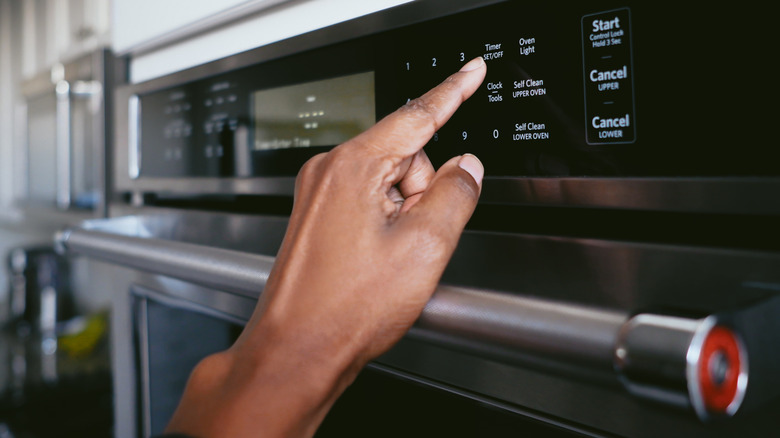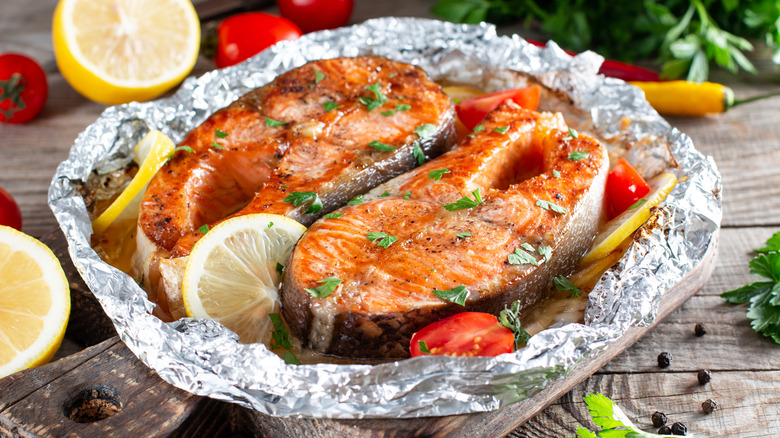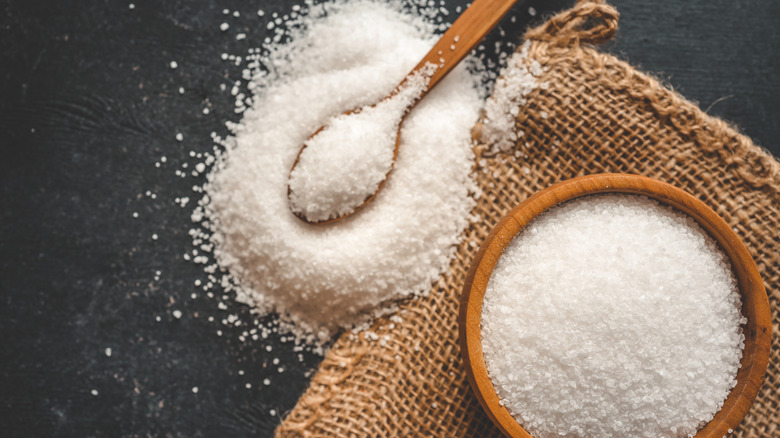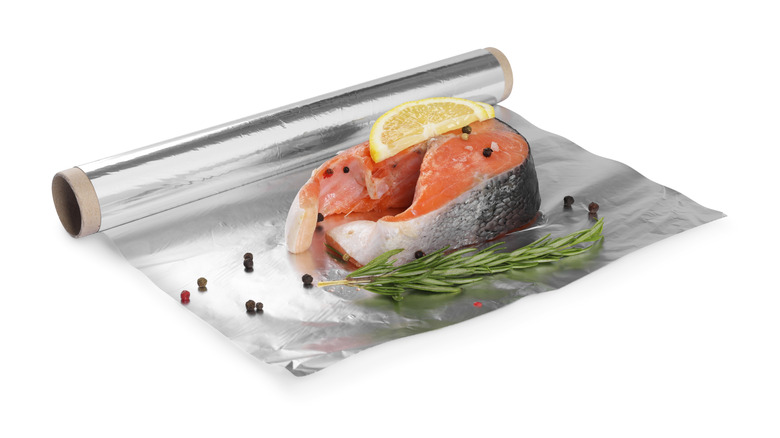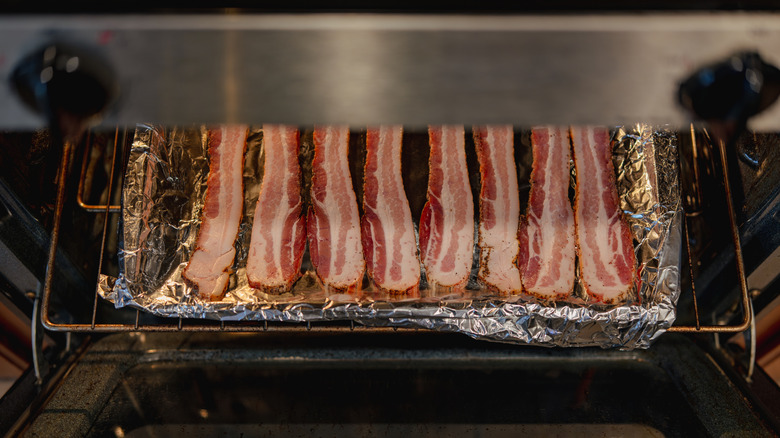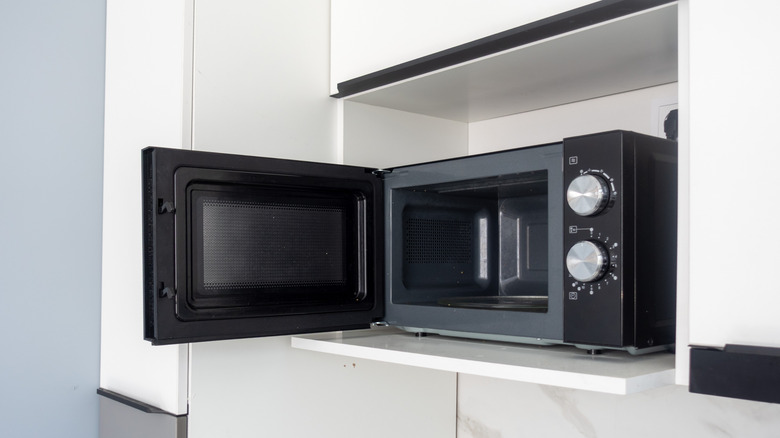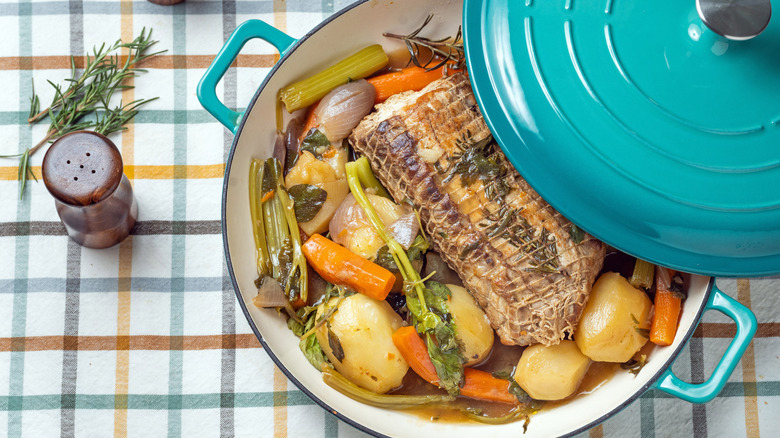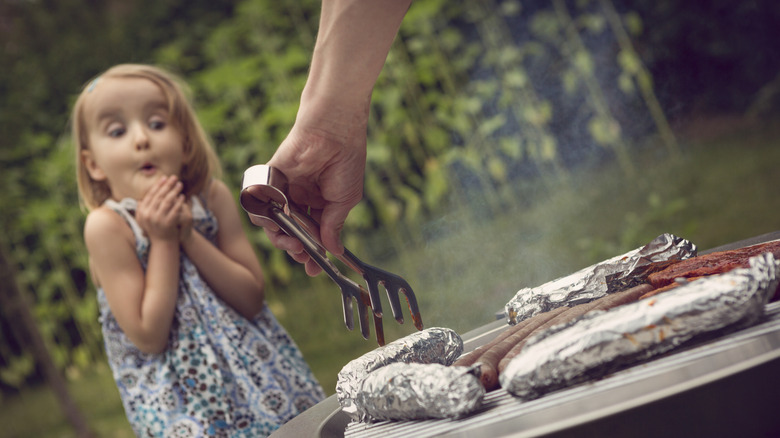10 Aluminum Foil Mistakes That Compromise Kitchen Safety
We may receive a commission on purchases made from links.
Aluminum foil is a tool that most folks reach for freely in the kitchen, and for good reason. It's endlessly useful, helping you make perfect bacon in the oven, keeping your air fryer clean, and starring in many other cooking hacks. However, that doesn't necessarily mean it's always safe to use. In fact, in some cases, it may be downright unsafe.
Mainly, that's because it can be toxic, explains Bryan Quoc Le, food scientist and author of the book "150 Food Science Questions Answered." That's because "Aluminum is a heavy metal that can interfere with many physiological processes in the body, and is fairly toxic in moderate concentrations," Le says. "Aluminum toxicity is poorly understood, but oral exposure to aluminum could stress individuals with kidney disease." However, he adds, "Small levels of aluminum are accepted as safe."
It's not just the kitchen you need to watch out for, either. "It's in antacids, deodorants, and even drinking water," says Blessing Jennifer Anyibama, a food and nutritional scientist at Tuskegee University. "Minimizing contact wherever you can is a wise choice, so be aware. Food safety isn't only about what you eat, it's also about what you cook it in." With that in mind, let's take a look at some of the most common aluminum foil mistakes that can compromise kitchen safety.
Discounting aluminum toxicity levels
One of the most common mistakes people make is assuming aluminum foil is harmless because it is ubiquitous. Thus, before discussing other aluminum foil errors, it's important to take a look at what exactly aluminum toxicity means. Because aluminum is a natural substance found in the earth's crust, water, and air, it makes its way into some of our foods. Thus, the body is equipped to process it to some degree.
But, Ken Tobby, the food scientist behind Organic Solace, notes, "Though the body has the capacity to excrete aluminum, excessive consumption for a long time can accumulate in the bones, brain, as well as other tissues, possibly resulting in serious health issues like bone disorders or neurotoxicity." Problems related to muscle function, kidneys, and biochemistry may also arise, says Bradley Lampe, Principal Research Toxicologist at NSF.
"A review from Health Canada in 2021 identified a safe (or tolerable) level of exposure of 0.3 milligrams per kilogram per day, or about 20 milligrams per day for a person weighing 60 kilograms," Lampe adds. That translates to about 130 pounds. Since a normal aluminum intake is between 12-14 milligrams a day, a typical person can't afford to take many chances with extra aluminum.
Cooking at too high a temperature
Another of the most common mistakes folks make with aluminum foil is cooking food at too high a temperature, which increases the chance that you will ingest it. It's perfectly natural to rely on the convenience of foil when grilling potatoes, say, or cooking a packet of fish. However, says Blessing Jennifer Anyibama, "High temperatures increase the rate at which aluminum leaches into food. At over 400 degrees Fahrenheit, you're essentially marinating your meal in a low-dose metal bath — unseen but not unfelt in the long run." If you just mimicked the alarm-faced emoji, then you're not the only one.
That's not to say you need to freak out about using aluminum foil in your cooking. If you use it infrequently for dry applications such as baking or grilling, Bradley Lampe says, you don't need to worry that much. Ken Tobby explains that, "At temperatures more than 400 degrees Fahrenheit, aluminum foil usually disintegrates easily, and its particles can find their way into your food." He adds that "Though the amounts might not have an instant health danger, constant exposure over a longer time could result in serious health issues."
Unfortunately, you may think you're cooking at temperatures lower than 400 degrees Fahrenheit, but ovens are far less precise than you think they are. Believe it or not, ovens reporting the same temperature can vary from one another by as much as 90 degrees, which doesn't inspire a lot of faith. If you're not sure how high your oven or grill actually cooks and want to be sure, just get an oven thermometer such as the Taylor 5932 Large Dial Kitchen Cooking Oven Thermometer.
Exposing it to acids at high heat
Exposing aluminum foil to acid at high heat compounds mistakes with mistakes. "Aluminum foil can become unsafe when it is used to prepare or store acidic foods at relatively high temperatures," Ken Tobby says, because it causes aluminum particles to percolate into food. "Besides, acidic ingredients such as tomato sauce or lemon juice speed up this process via chemical reactions that wear away the foil's surface." Specifically, he says, acids disintegrate the foil's oxide layer, which typically shields it, freeing up aluminum ions to enter your meal.
Plus, Blessing Jennifer Anyibama adds, the chemical reaction can even alter the taste of your food. "It's a hidden exchange most people aren't aware they're making at the dinner table," she says. For that reason, it's best to avoid combining foil, acids, and heat. Where possible, you may even wish to keep acids away from foil altogether, since the chemical reaction can occur even without the presence of heat.
Which foods should you avoid, then? Bradley Lampe recommends you steer clear of apple purees, rhubarb, tomato purees, citrus fruits, pickles, and other vinegar-based foods or sauces when using aluminum foil.
Combining it with salt and spices at high heat
As if acids weren't enough, salt and spices can both cause aluminum to migrate into your food as well. "Salt promotes the solubility of the metal," Ken Tobby says, again helping it break down and dissolve into the ingredients around it. Again, he says, leaching occurs mainly during cooking, particularly if you're working at high temperatures.
To understand this, it's necessary to once again turn to science. "Upon exposure to air, aluminum forms a thin surface layer of aluminum oxide that protects the interior from further corrosion, much like stainless steel," Bryan Quoc Le explains. "However, salts and certain compounds known as chelators that can be found in spices can slowly erode that aluminum oxide layer. This leaves the highly reactive aluminum core exposed to further corrosion."
The good news is that it's easy to avoid such mistakes. As with acidic ingredients and high heat, simply don't use aluminum foil if your ingredient list calls for salts and spices. Note too that salt and spices aren't the only alkaline foods. Anything with salt in it represents a hidden danger as well, such as salted meats. Alkaline substances may also not always present as salt. Bradley Lampe cautions that you should beware of lye doughs as well, such as pretzels and bagels, because lye is a highly corrosive alkaline product.
Cooking with lots of liquids
There are so many dangers in the kitchen (knives and burners and blenders, oh my!), but you wouldn't typically think of liquids as numbering among them, at least if they aren't boiling. Yet freely allowing liquids access to foil is another of the most common mistakes when it comes to aluminum.
"Cooking with aluminum and liquids can be potentially dangerous due to the metal's capacity to leach into your food, particularly when used with reactive ingredients such as salt and acids and at high temperatures," Ken Tobby says. "Liquids enhance the dissolving of aluminum, enabling it to blend easily with food." Of course, a little aluminum exposure here and there isn't a major concern, he says, but over time it can pose significant health risks. "To limit this risk, it is advisable to avoid boiling or simmering foods in aluminum foil or pots, particularly when preparing sauces, stews, or soups that have salty or acidic components."
Some non-liquid dishes still produce lots of liquids, such as roasts. "That sizzling pot roast might carry more than flavor," Blessing Jennifer Anyibama warns. "It could be infused with metal ions, subtly impacting your health meal after meal." If you really must cook a wetter item in aluminum foil, try to remove it from the aluminum as soon after cooking as you can. The same goes for if you're using aluminum pots and pans, Bradley Lampe says. And whatever you do, don't store food in aluminum foil, which just gives it more time to absorb the element.
Using the wrong side
Whether to use the dull or shiny side of aluminum foil is a question that many home cooks (this writer included) have asked over the years ... but then utterly failed to Google. If that's you, hey, we've all made worse mistakes. Turns out, there's not as much of a difference as you might think. For instance, Reynolds states on its website that both the shiny and dull sides of both standard and heavy-duty Reynolds Wrap aluminum foil work the same. The only reason one is shinier than the other is that one gets polished more heavily during milling.
That said, while aluminum foil is safe for low-temperature storage and cooking free of the above substances is fine, Bradley Lampe warns that "it's always important to follow the manufacturer's instructions." With Reynolds nonstick foil, the dull side is the treated side, and it will be printed with the words "nonstick side." This will vary according to each brand, so make sure you read the instructions.
Worried about the treatment used to make that foil nonstick? Happily, research hasn't revealed high levels of PFAS or perfluorinated chemicals in aluminum foil. These additives are used in other nonstick products that are sometimes referred to as "forever chemicals" because, well, they stick around forever and can cause serious health problems. In this case, at least, it appears that the biggest concern is buying nonstick foil and then accidentally using the sticky side. Whoops.
Lining your oven or cookie sheets with it
In many ways, foil is an excellent cookie sheet liner in that it conducts heat well, protects the pan, and gives you that nice golden bottom that you want in a good cookie. However, it's probably not the best tool for the job. "Constant exposure to relatively high temperatures can fuel the danger of aluminum leaching," Ken Tobby says. For that reason, he recommends that you use silicone baking mats or parchment paper, which are considered safer. Either the Amazon Basics Reusable Rectangular Silicone Mat or SmarTake Parchment Paper Baking Sheets will do the trick nicely.
As for ovens, foil can get a little scarier. "When lined in your oven, it can inhibit airflow, interrupt the distribution of heat, and even thaw at increased temperatures, possibly destroying your oven," Tobby says. Plus, Blessing Jennifer Anyibama adds, it can even spark fires.
Admittedly, Bryan Quoc Le says, foil is handy in ovens because it protects against spills, and not much of it will transfer to your food if it's not actively touching it. If you're going to use foil on the bottom, just make sure it's not touching any elements or blocking any air holes, and change it when it becomes dirty or grease-encrusted.
Putting it in the microwave
Foil is endlessly useful in cooking weekday staples such as baked potatoes. As it happens, so is the microwave. However, while you can cook potatoes in the microwave, and it's handy to wrap them in aluminum foil as long as you don't care about them getting crispy, the two do not go together particularly well.
Now, this point is a little polarizing, as some sources have removed aluminum foil from the list of microwave mistakes recently. They claim that you can put it in there as long as you follow certain procedures: use only new foil, stand back, and cover only a small part of the food. One has to wonder, though, whether advice that comes with a warning list this long is really safe at all. Or at least, it's not guaranteed to be safe, which is what most of us look for in an easily avoidable cooking hack.
So ... can you put foil in the microwave or not? That's where the science comes in. Microwaves generate electromagnetic fields, which cause food molecules to vibrate at a specific frequency and heat up. Those electromagnetic fields don't stop there, though; they also cause currents to run through metal. In the case of aluminum, which is very thin, the metal is in danger of heating up quickly, causing fire. Any crinkling can also cause sharp edges that result in sparks. These sparks can potentially create a fire. Hence, the advice is to use small, smooth pieces and stand back. Bottom line: It's up to you, but baked potatoes are plenty easy in the oven.
Failing to consider alternatives
The good thing about aluminum foil is that, useful as it is, there are many alternatives on which you can rely instead. Instead of making the above mistakes, start making smart swaps. For instance, Ken Tobby says, "It is safer to always use non-reactive cooking utensils such as stainless steel, ceramic, or glass when preparing salty, acidic, or spiced meals."
"For grilling," Blessing Jennifer Anyibama adds, "stainless steel baskets or cast iron pans give you the crisp without the compromise. These alternatives are safe, sustainable, and metal-leach-free." Items such as a Lodge 12-Inch Pre-Seasoned Cast Iron Skillet or a Lodge Cast Iron Serving Pot Dutch Oven With Dual Handles work equally well in the oven, on the grill, or in a bed of campfire coals. Cast iron is, quite simply, a classic for a reason. Even better, Bryan Quoc Le says, "These materials do not dissolve or corrode easily in the presence of salt and acid."
As for food storage, try a metal-free option. While plastic wrap works well, it's not very sustainable. The experts recommend reusable beeswax wraps. These are self-sticking, so they cling both to the edge of the food container and to themselves, giving you a nice seal. Plus, the waxed cloth is easily cleanable with soap and water. The truly DIY savvy will find them easy to make at home, but if you'd rather point and click, Bee's Wrap Reusable Beeswax Food Wraps are a good option.
Overusing it
Of the many mistakes you may make when using aluminum foil, overuse is one of the most basic and simplest to correct. The fact of the matter is, it is often the easiest material because it insulates and conducts heat really well. Plus, it is sturdy and strong, working equally well as a cooking and food storage tool. However, it's a material that often has other substitutes, depending on the application.
TL;DR: Make an effort to move away from constant use, especially in hot applications. "In general, foil is safe for refrigerated or cool food storage," Bradley Lampe says, so you don't need to worry about it in such situations. However, he says, sometimes it really is the best tool for the job. In that case, you can use it while putting protective measures in place. "If you are preparing highly acidic, alkaline, or salty foods, use a piece of parchment paper on top of the foil to create a barrier between the foil and the food."


